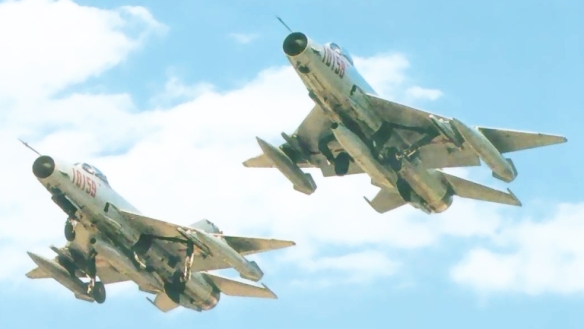
Chengdu J-7G/F-7MG Fishbed
J-7E2
Around this time China also started to emerge from its dependency on Soviet aircraft with the Chengdu J-7, which was a licence-built variant of the MiG-21 Fishbed – itself a second-generation fighter jet.
The so-called Sino-Soviet ideological split, which had ideological differences over how to deal with the west at its heart, had severed the relationships that had previously built up and seen cooperation on the development of new aircraft. In 1962 the Soviet Premier Nikita Khrushchev wrote to the Chinese offering to re-open mutual development work in the aerospace field. One part of the new relationship would see MiG-21 technology transferred from the Soviet Union to China. This was the first step in what was going to be a journey that would last for several decades as China developed its own indigenous capabilities to build fighter jets.
A number of MiG-21s in kit form were sent to China to allow Chengdu J-7 production to start in March 1964. However, only 12 of the J-7 were produced due to inadequate documentation provided by the Soviets. Yet the Chinese persisted, subsequently solving numerous problems that had hampered the operation of the MiG-21 – a long-term approach now known as reverse engineering.
Having initially built the J-7 under licence the Chinese embarked upon an extensive modifications programme that would see new variants appear with greater indigenous Chinese elements involved in the development. The first domestic variant of the MiG-21 was called the J-7I (Improved) and went into service in June 1976. It was armed with two 30mm cannons and could carry two PL-2 missiles. However, it was less successful than its predecessor and at times up to 70% of the fleet were grounded by major flaws in the hydraulics systems.
The J-7I (Modified) resolved many of these problems in the late 1970s. It was followed by the J-7II and the J-7IIIA – and included the first British-made Type 956 Head Up Display (HUD) deployed by the Chinese. The Type 956 was developed by GEC Marconi Avionics and the deal came out of a brief period of rapprochement between the West and China in the early 1980s.
The J-7E emerged in May 1990, bearing developments including improved double-delta planform wings, increased wingspan and double the previous fuel load. These developments were led in part by the need to try to prevent American reconnaissance missions over China and also by the country’s increasing pre-occupation with Taiwan; something requiring additional range and payload capabilities. The J-7E entered service in 1993 and remained in production until 2002. Today it remains in service in many of the Air Regiments in the People’s Liberation Army Air Force (PLAAF) with an estimated 144 still flying. Over 50 of the J-7G, the final development of the variant, also remain in service – these using an indigenous version / copy of the EL/M-2001 radar developed in Israel.